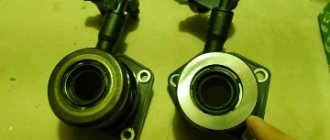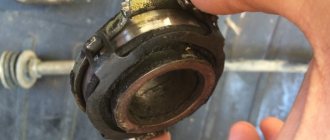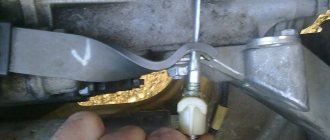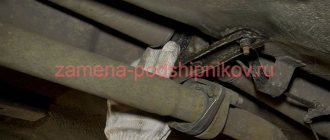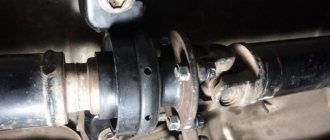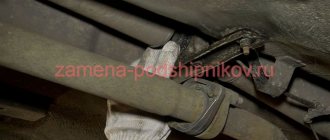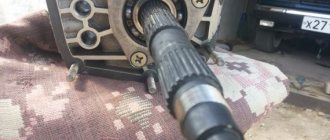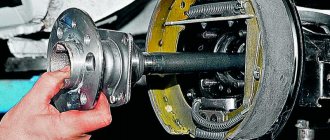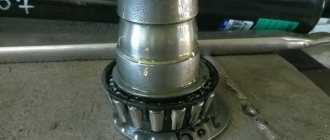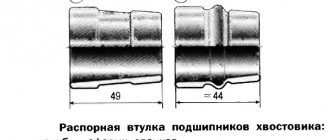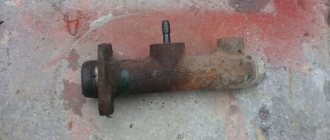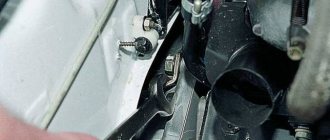FakeHeader
Comments 31
this is the input shaft bearing... the same problem, but I stopped paying attention a long time ago, since you install a new one and there is an option that the same thing will happen... spare parts are crap. I advise you not to touch it yet
By the way, when you remove the box, be sure to check the plug for cracks, they often break
This is a box. When depressed, the clutch disengages and the sound disappears. In most cases this is the large input shaft bearing. If the noise is minor, it's okay. I drove 40 thousand with such a bearing, changed all the bearings when the noise really became annoying. The release mechanism makes just the opposite noise when squeezing, as described below.
the noise is not annoying, but as if delaying this problem would lead to consequences) and they seem to be there)
In the best case, if the bearing jams, it will turn, in the worst case, the bell will break, but that’s when it will make a terrible noise. If possible, you can change
And the fact that the clutch is hard and gives vibration to the pedal is already a problem for the clutch. First, check how the working cylinder rod moves. For a long time I had the problem that the pedal became hard and the gears were difficult to engage. The reason was in the hose that runs from the body to the working cylinder, for some reason it was corroded, it was all swollen and, as a result, it did not allow fluid to pass through well. I’ve never encountered anything like this before, and I’ve never heard from people about it. But I had the same problem.
Take off the gearbox and see if you buy a used clutch, then buy a centering device for the clutch disc) otherwise I’m tired without it
I already thought about this by the way) I was looking at the Schemers program on Discovery and just saw how Ed used a shaft from some machine to center the disk, you will definitely need to get a centering machine)
here it costs 50 rubles)
- there is no lubrication in the release lever - the clutch basket may have fallen apart - perhaps the damper on the clutch disc has fallen apart, that’s what happened)
The lubricant has run out and it whistles.
When the noise died down, did you press the pedal or let it go? Maybe try adjusting it first. Regarding the clutch, the Master said that now the easiest way is to take a VIS and skate 50-60 thousand freely, and then maybe the whole hundred.
6 seconds squeezed the clutch, 9 seconds released, also 15 squeezed the clutch 16 released. We regulated it a year ago, we should try to start with this
It’s not a release lever, it’s the other way around, when you squeeze it out it starts to make noise, it’s the input shaft bearing, most likely yours is noisy, when you squeeze the clutch it goes quiet, the release starts making noise. They are there for 100k mileage, it seems, they are designed taking into account spare parts, or rather their quality, they last less
I have the same crap, but the mileage is 23,000 km
At first, the bearings can howl in cold oil in the box, then you can’t hear them, the mileage after overhauling the box itself is 3k, but the primary bearings also make a little noise in cold oil. I try to ride the first 100-200 meters at XX to warm up the oil in the axle box. Everything also depends on the oil, change the oil in the axle box every 60k, but in fact the axle is 15k, the gearbox is 30, then it’s better to change it. Well, again, the quality of the spare parts, I had almost 100k mileage, the bearings were all on the verge of death, and the fork was also very worn out.
Having your own car does not require a thorough knowledge of its structure. But the baggage of technical knowledge is never a burden. Knowing the signs of a faulty clutch release bearing, you can prevent an accident or equipment failure at the most inopportune moment. Acting proactively always minimizes repair costs. It is more difficult to deceive an informed person and inflate him with an unjustified price. It’s easier for him to know how to identify a problem and what to do in trouble.
Purpose
To understand where the release bearing is located, you need to understand the purpose and design of the clutch. The clutch and all its parts belong to the vehicle's transmission. It ensures the transmission of torque from the engine to the drive axle and wheels, and must be located between these parts of the machine. But an important condition for the location is accessibility in its control by the driver. Most often this is the clutch pedal, less often the lever near the steering wheel. Using the clutch mechanism, the driver periodically disconnects the engine from the transmission. This allows you to stop the car, change the gearbox, and change the driving dynamics.
How to change the release bearing on a VAZ 2114 with your own hands - step-by-step instructions with a disassembly diagram
It was previously noted that the process of replacing the VP is difficult precisely when removing the gear shift unit, so first study the device to understand the intricacies of dismantling.
List of necessary tools for replacement: – Two jacks and supports; – A set of spanners with a ratchet; – Mount; – Minus screwdriver; – Container for draining oil.
Device
An important component of the clutch is the release bearing. It is located on the input shaft of the gearbox and uses a push clutch to apply pressure to the inner ends of the levers. These levers directly connect or disconnect the clutch release and driven discs. It is important to remember that the default clutch position is engaged. But when you press the clutch pedal, the clutch discs disengage.
We must realize that all these elements are involved in the transmission of enormous power. The release bearing is subjected to large mechanical loads, affecting its wear. It is also commonly called “thrust bearing”. Some vehicles use a thrust bearing. It is also called the thrust bearing. There are models in which this element is absent altogether. For example, VAZ-2108.
The ball bearing is a well-known element of any car. The operating principle of any bearing and its structure are familiar even to a schoolchild: a cage, an outer and inner ring, balls, a raceway.
The VAZ 2107 clutch is designed to connect the engine crankshaft and the gearbox input shaft with the possibility of briefly stopping the transmission of torque. The reasons for its failure can be very diverse. However, all of them can be easily diagnosed and eliminated on their own.
We change the release bearing on a VAZ 2114 with our own hands - dismantling the gearbox
Provide sufficient lighting above the hood of the car, put the car in first gear, and release the handbrake. If possible, ask a partner for help. Below is a detailed dismantling technology, according to the diagrams presented above.
- Open the hood, unscrew the air filter mounts, disconnect the wire and remove the assembly (see photo). After this, disconnect the battery terminals, and to be safe, remove the battery.
- Now we get access to the upper gearbox mounting bolts. Unscrew the long bolt at the back, the short one at the front.
- Let's move on to the starter. We unscrew the two upper studs, then remove the terminals. Now we look for the clutch cable that comes out of the gearbox, twist the nut to loosen the tension.
- We go down to the wheels, tighten the bolts, and remove the chassis. We tear off the nuts of the VAZ wheel bearings to remove the drive axle shaft on both sides. Use the pipe to extend the key.
- We remove the anthers (mud flaps) with a 8mm wrench, then unscrew the engine crankcase protection bolts.
- We find the suspension arm extension bracket (3.4 in the diagram), unscrew the rear nut with the lower bolts.
- Now unscrew the anti-roll bar bolt (8) on the right side, then the ball joint bolts on both sides (key 17). Then remove the lever (7) together with the stretcher (4).
- The gearbox is half disconnected, now we unscrew the plug to drain the oil.
- After draining the oil, remove the wheel drives. First, we remove the CV joint “grenades” from the hubs, then we take the splined side of the shaft out of the box using a pry bar.
- On the side of the box we disconnect the reverse terminal. We find three bolts securing the gearbox to the engine and twist them.
- To remove the starter, unscrew the two bolts from the bottom.
- Now we disconnect the gear shift rod (10) and dismantle the rocker. The speed sensor terminal is located nearby; disconnect it (see photo).
- We unscrew the locknut to disconnect the gearbox from the side support (cushion), then use a long wrench to unscrew the two fasteners of the rear cushion (9).
- All that remains is to unscrew the two gearbox bracket bolts (2) and disconnect the unit from the engine.
- We dismantle the assembly, hold the body with one hand, and move it with the other using a mount. After removing the assembly, we proceed to replacing the release bearing.
How to change the clutch without removing the gearbox
Detailed replacement process on video
Clutch mechanism of VAZ 2107
The VAZ 2107 clutch is a rather complex mechanism consisting of several dozen elements. The reasons for its malfunction can be very different. However, they can all be divided into two groups:
- Defects in the clutch mechanism itself. These include malfunctions of the driven part of the clutch, pressure device, basket, flywheel, and clutch fork.
- Defects in the hydraulic drive of the clutch mechanism. They can be caused by leakage of the working fluid, the formation of an air lock in it, as well as malfunctions of the main or working cylinders (MCC and RCC) and the pedal mechanism.
The clutch, like any other car part, has a limited service life. First of all, it depends on the skill of the driver, and therefore is not regulated by the manufacturer. To increase the service life of the clutch, it is necessary to adjust it in time, monitor the level of working fluid, avoid off-road driving, and learn the skills of using the clutch correctly.
It must be remembered that in addition, the clutch is a safety device that protects the transmission from serious damage when the rear wheels are blocked by various obstacles. The car is stuck in a quagmire, the drive wheels are stuck, the engine power is enough to turn the stuck tires. In this case, the clutch will begin to slip, protecting the gearbox, cardan and rear axle from damage. Yes, the driven disc linings will burn out. Yes, the clutch will overheat, which can cause the steel flats to warp or weaken the spring plates. But more expensive units will be protected from breakdowns.
Classic VAZ models have a dry, permanently closed single-plate clutch . It includes two main elements:
- Leading part. It consists of a driven disk, the splined part of which transmits rotation to the gearbox due to friction between the friction linings and the surfaces of the flywheel and pressure plate.
- Non-removable drive unit (basket). The basket is attached to the flywheel and consists of a pressure plate and a diaphragm pressure spring.
Reasons for replacing and adjusting the VAZ 2107 clutch
Replacing a VAZ 2107 clutch is a rather labor-intensive and expensive process. Therefore, before replacing, you should consider adjusting the mechanism.
Clutch replacement
To install a new clutch, you will need an inspection hole, overpass or lift. It is important to detect in time the signs indicating the need to replace the clutch (it is impossible to replace it on the road), and take the car to a garage or car service center. Driving with a faulty clutch is very dangerous - you can get into an accident when crossing a railway crossing or a main road.
The entire VAZ 2107 clutch is replaced, so auto shops sell a kit consisting of a driven disc, a basket and a release bearing. You should consider replacing the clutch in the following cases:
- the car climbs heavily uphill when the accelerator pedal is pressed all the way down, and you can smell a burning smell - these are signs of slipping of the driven part of the clutch;
- when the clutch is disengaged, noises appear in the area of the flywheel housing - this indicates a malfunction of the release bearing;
- when starting the car, it is difficult to engage first gear (the gearbox “growls”) - this is a sign that the clutch is not completely disengaged (the clutch is moving);
- when accelerating, the car begins to twitch, rattling sounds are heard - the reason for this is usually broken damper springs or loose sockets for them on the driven disk, deformation of segments or loose rivets on the hub.
Any noise, vibration, or whistle in the clutch area requires more detailed diagnostics and diagnosis.
Clutch adjustment
If the clutch pedal becomes too soft, falls down, and does not return to its original position, then most likely air has entered the system or the hydraulic drive adjustments have been disrupted. Clutch slipping after prolonged use usually indicates a failure of the clutch. It will probably have to be changed.
If the clutch drives, that is, shifts gears with difficulty, in about half of the cases the reason is a discrepancy with the required values:
- play between the rod and the piston in the working cylinder;
- clearance between the release bearing and the fifth basket;
- free and working travel of the foot pedal.
Notes, recommendations and repair tips
1. The average service life before product replacement is 800,000 off-on cycles. 2. Recommendations for extending the life of the release bearing: – Avoid holding the pedal for a long time; – It is advisable to release the pedal slowly and press quickly, without stopping between the extreme positions; – Prevent moisture and dirt from entering the transmission; – Carefully lubricate the part during the replacement process (see video below). 3. After replacement, when performing reassembly, treat the threads of bolt connections with graphite lubricant. 4. Purchase auto parts from previously proven retail outlets, check dealer documents and product quality certificates. 5. The video shows an example of performing repairs without an inspection hole, as well as without removing the gearbox.
Diagnosis of clutch faults VAZ 2107
External manifestations of a VAZ 2107 clutch malfunction are:
- difficulties when changing gears;
- slippage of the driven part;
- vibration;
- pressure bearing whistling;
- tight pedal assembly;
- the pedal does not return to its original position after pressing;
- other signs.
Clutch slipping
You can check whether the clutch is slipping as follows. The third or fourth speed is turned on and the handbrake is pulled. If the engine hums, the car does not move, and there is a burning smell in the cabin, it means that the driven part of the clutch is slipping. This can happen for several reasons.
- The pedal has little play. If a problem is discovered after replacing the clutch, the cause is incorrect adjustment of the hydraulic drive. Lack of clearance between the pressure bearing and the fifth basket results in the driven disc not being clamped properly. It is necessary to adjust the length of the pusher, setting the play to 4–5 mm.
- When starting from a stop or while driving on an uphill slope, the clutch burns, that is, acrid smoke begins to come from below. This indicates wear or burning of the driven disk linings, made of friction-resistant composite material. In this case, the clutch must be replaced.
Clutch leads
If the clutch is moving, it becomes very difficult to engage first gear, and if the clutch is disengaged, the car does not stop and continues to move. When the pedal is pressed, the driven disk remains clamped, that is, it is not disconnected from the flywheel and pressure disk. This situation may be due to the following points.
- There is too much clearance between the pressure bearing and the heel of the pressure plate. As a result, the clutch does not disengage completely. The length of the RCS rod should be reduced so that the distance between the bearing and the fifth becomes 4–5 mm.
- Mechanical damage to the driven disc due to overheating of the clutch in difficult vehicle operating conditions. This leads to the appearance of fine shaking in the transmission when the end runout exceeds the permissible 0.5 mm. In this case, it is better to replace the clutch with a new one.
- Pulling out the rivets on the friction linings and, as a result, increasing the thickness of the driven disk. The driven disk needs to be replaced.
- Wear of internal splines on the driven disk hub. This can lead to jamming on the gearbox shaft splines. If wear is detected, lubricate the splined part with high-quality automotive lubricant LSC-15 or replace the parts with new ones.
Jerks when starting and changing gears
If the car starts to twitch when starting from a stop and changing gears, the reasons for this may be the following situations:
- The driven disk is jammed on the gearbox shaft splines.
- There is oil in the basket.
- The hydraulic drive is misaligned, the RCS piston is jammed.
- The friction linings are badly worn.
In these cases, the following measures are taken:
- replacing the entire clutch;
- repair of hydraulic drive devices;
- removing air from the hydraulic drive by bleeding.
Noise when clutch is disengaged
Sometimes when you press the clutch pedal you hear a sharp whistling and grinding noise. The reason for this may be:
